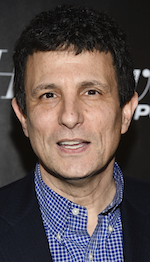Monday’s awarding of Public Service Pulitzers to both the New Yorker and the New York Times — for “explosive, impactful journalism that exposed powerful and wealthy sexual predators” and spurred “a worldwide reckoning about sexual abuse of women” — marked a historic breakthrough for the prizes. The 93-year-old New Yorker became the first magazine to win a prestigious Pulitzer gold medal.
But it was even a more special first for 30-year-old New Yorker reporter Ronan Farrow, whose initial four stories for the publication earned it that Pulitzer.
“In a way it seems impossible that the story is even out, let alone that it won this prize,” Farrow said in a telephone interview. As has been reported before, Farrow began his investigations, focusing on Hollywood mega-producer Harvey Weinstein, while working at NBC, but had become unhappy with his support for getting the story on the air. He then moved to the New Yorker after his NBC contract ended, where his backing dramatically increased, to put it mildly.
A review of the Pulitzer Public Service entry material submitted by the newspaper and the magazine suggests that the Times followed its time-honored, meticulous formula for promoting its entry — and winning. (It has more Pulitzers than any news organization, and now has tied the Los Angeles Times for the most gold medals, six.) The New York paper packaged 18 separate articles on sexual harassment with more than 20 bylines, published between last April and December.
The Times entry began with the Oct. 5 article by reporters Jodi Kantor and Megan Twohey that broke the Weinstein story with vivid accounts from women of their abuse by Weinstein. (The producer, who has denied any sexual interactions with women that weren’t consensual, later lost his movie empire because of the charges and the news articles.) Kantor and Twohey were cited on the Times’ Pulitzer certificate as the paper’s lead reporters for the winning sexual harassment work. The Times package also included two editorials, and opinion articles written for the Times by actresses Salma Hayek and Lupita Nyong’o.
By contrast, the New Yorker entered only Farrow’s four long Weinstein features from October and November — the first of them appearing online four days after the Oct. 5 Kantor-and-Twohey article. (Farrow, also a former NBC show host, notes that he had written numerous op-eds over the years, but only one other long-form story before he joined the New Yorker: a February 2014 cover profile of Miley Cyrus for Conde Nast’s W magazine.)

New Yorker editor David Remnick said in a telephone interview that, compared to the Times, “we’re pretty new to the game” of entering for Pulitzers. It’s learning fast. Magazines have only been able to enter the once newspaper-centric journalism Pulitzers, in certain categories, since 2015. But in 2016 two New Yorker writers became the first magazine journalists to win Pulitzers, for Feature Writing and for Criticism. (All journalism categories are now open to magazines.)
Remnick says that Farrow, who has a Yale law degree, possesses all the qualities necessary for Pulitzer-level work. “This is a guy of unusual intelligence, raw talent, and enterprise and drive,” he said, and he has worked exceptionally well not only with Remnick, but with senior editors assigned to him.
Of the story idea Farrow brought to the magazine, added Remnick: “We had the sense that this particular story — the Harvey Weinstein story — was for want of a fresher phrase a tipping point.” And in addition to the suggestion that it could ignite a far wider discussion of sexual harassment, “there was something particularly outsized about this case … grotesque,” Remnick said.
“I was completely wet behind the ears,” Farrow admitted about his first interactions with the New Yorker. “But I learned quickly that this is one of the great institutions for this kind of work. All of us writers crave good editors and dread bad ones,” he said. “And there are no bad ones at the New Yorker.” He specifically noted editor Deirdre Foley Mendelssohn, and online news director David Rohde, a former New York Times war correspondent and himself a Pulitzer-winner. Of Mendelssohn, he said, “She has an infallible ear for language, and an ethical ear.” For one thing, “she weighed in on when to use the word rape.” Farrow reserved special praise for magazine general counsel Fabio Bertoni’s work on a story with so many legal complications.
Plus, “there was this accident of history,” said Farrow, that New Yorker veteran Ken Auletta had written on Weinstein years ago, and encouraged the newcomer to pursue the story anew.
Farrow and Remnick agreed that their own editor-reporter relationship on the Weinstein story became extremely close. “Ronan even came over to my house for a couple of days running, and there was a lot of back-and-forth” involving story drafts and reporting, said Remnick. “What was impressive was to watch and listen to him on the phone” with victims — “to get them to talk, and to be on the record.”
Said Farrow of Remnick, “He was extremely tolerant of this young, green reporter, fighting him on edits.” But that reporter kept in mind the importance of his early support from the top at the New Yorker, after a period when “I was on pins and needles because this story was so imperiled then, and my future was in doubt.” He added, “I was trying to live up to the commitments I’d made to my sources.”
Despite the differences between the Times and New Yorker Pulitzer entries, the Pulitzer Board’s decision to give both publications gold medals came easily, said Pulitzer administrator Dana Canedy in a phone interview. "On that point there wasn’t a lot of debate at all in the board discussion”, she said. “I think the feeling was that this story, and its impact, was something the New York Times and the New Yorker equally dominated.” Indeed, the seven-person Public Service jury of journalists that had forwarded its choices to the board found the Times and New Yorker entries "far and away beyond everything else we examined,” and expected each to be given a prize, according to one juror who asked not to be identified. (The Kansas City Star got the nod as a third finalist, for its detailed examination of secrecy in the Kansas state government.)
The New Yorker’s Remnick, like most editors, claims that the Pulitzer is never the goal of the reporting. “Ninety-nine percent of it is thinking about stories, not prizes,” he said, adding with a laugh: “But of course we did [think about the Pulitzer possibility.] We’re not that innocent or high-minded.” For the New Yorker’s first gold medal, Remnick added, “We’re very honored to be there with the New York Times.”
As a final note, Farrow said that “the entire experience of seeing the story explode on the world is kind of surreal. I’m glad I didn’t let my sources down. They correctly feel that this prize is a tribute to them.”
Editor's note: The general counsel for The New Yorker is Fabio Bertoni. An earlier version of this story misspelled his last name.







